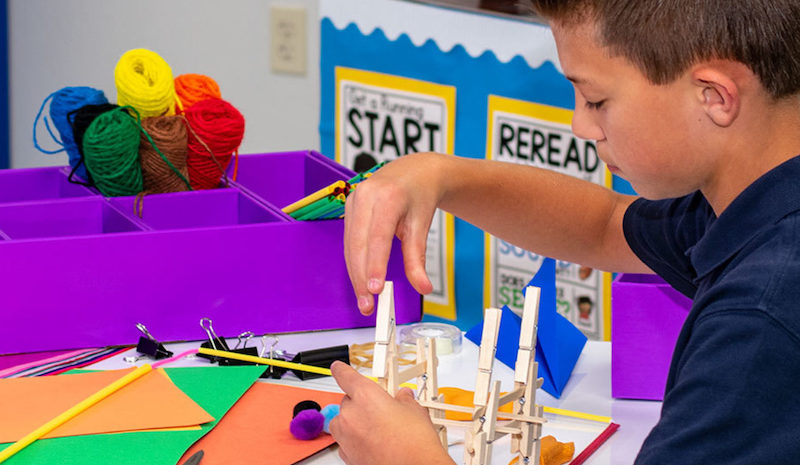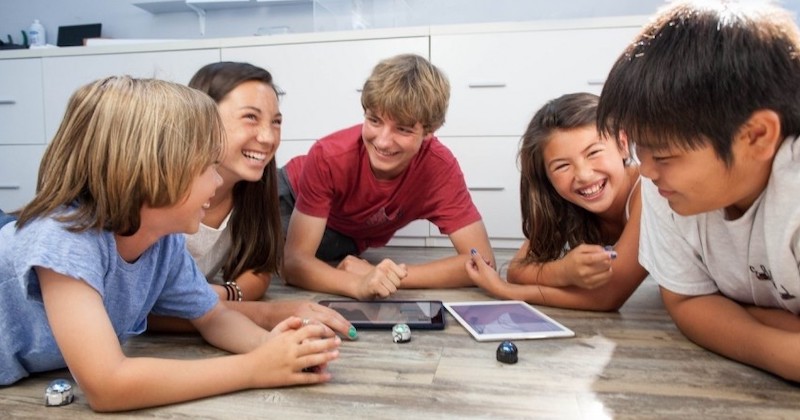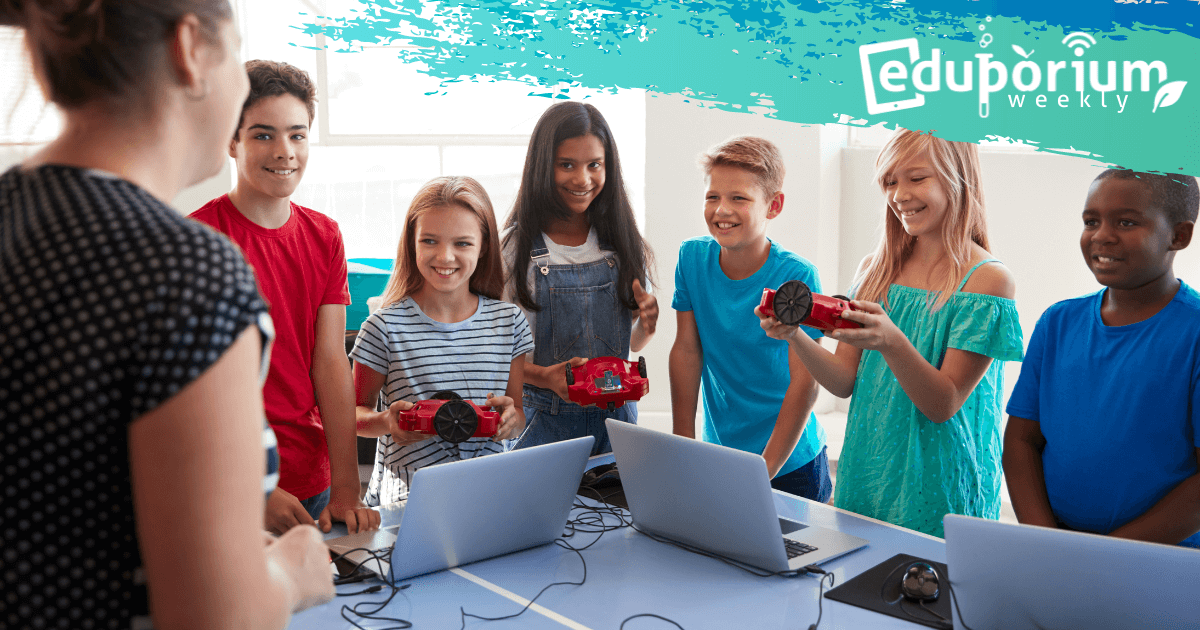Many kids love STEM experiences in their education and many teachers love creating those opportunities. They won't typically just fall into place, however, and, like all lesson plans, require careful design. In STEM education, lesson plan options are almost endless. This can also make it easier on instructors to locate or create something that's relevant to the classes they're teaching. Educators could research and implement various STEM curriculum options found online or they could go a different route. Many STEM tools these days also come with their own lessons and activities, adding extra layers of reliability and helping teachers to maximize each of these instructional resources.
Elements of a Good STEM Lesson Plan
When designing lesson plans, instructors can make them simple or in-depth depending on time and what they're covering. STEM learning gives students more chances to participate in something rather than just reading about it. Since STEM is often very much hands-on, educators can try to make this a priority when designing lessons. In the best hands-on STEM lessons, children are able to interact with various materials and utilize their creativity to design and build something tangible. If group work is possible, this could also expose kids to playing different roles and collaborating effectively. Plus, when learning is largely hands-on, students are typically better able to focus and stay interested in their projects.
STEM relevance and connections.
Another dynamic element of STEAM lessons is making them relevant to common or current issues. When students can identify connections between projects and issues they encounter in their everyday lives, they tend to become more engaged and less likely to wonder when they are going to use this knowledge. When they're more engaged, students ultimately end up retaining more knowledge over time as well. Also, STEM activities should involve references to math and science content when possible. Teachers can strategically weave these references in to help children make those curricular connections. This could help drive their curiosity, lead them to crave solutions, and ultimately keep engagement high.
Creating connections through STEM.
Besides making learning hands-on for students, there can be some other intent used as well. Engineering is still a huge area within the STEM economy, and introducing children to the engineering design process as part of classroom activities can help get them thinking in new ways. By applying this process, students get to systematically solve problems with actual relevance. And, finally, one other element of STEM lesson planning is to allow for collaboration whenever possible. Working as part of a team can help students build communication skills, encourage critical thinking, and demonstrate the importance of applying persistence and creativity. Seeing that much of what they learn about in the classroom is connected can help students develop a genuine interest in using today's techniques to solve key problems.
Creating a STEM Lesson Plan
There are obviously a number of ways in which instructors can design these lesson plans. By now, most of them likely have their own strategies or systems for designing lessons more quickly and efficiently. When it comes to STEAM learning, however, some of the elements of a good STEM lesson may be new. The goals and experiences teachers want to create with STEM lessons may be a bit more complex than in traditional instruction, meaning they may require a bit more planning. One way to start out is to think about how each letter of 'STEM' relates to the context and goals of the lessons. This makes it easier to tie lessons to these important pillars. Staying broad and following a guide can really help make the design process easier, too.
Getting started with STEM lesson design.
To begin, it's sometimes helpful for educators to decide which letters from 'STEM' will be the focus. It's a common strategy to include examples and learning opportunities that cover at least two of them (any two are fine). Even if instructors are teaching a subject we wouldn't consider a 'STEM subject,' they could still look for ways to weave STEM teaching methods into the equation. It's often best if the lessons can help kids see how the elements of STEM often come together to add more relevance as opposed to remaining separate pieces of the lesson. A good first step for educators, as a result, is brainstorming the subject for each lesson. After deciding on an umbrella topic, making a list of all relevant subtopics can help to spark discussions among students, too.
Other elements of STEM lessons.
STEM lessons should also give students opportunities to investigate something. In lesson design, teachers can provide context that gets students thinking about hypotheses they may want to state. This should also help teachers identify which letters in 'STEM' they'll be focusing on for that particular lesson. Once they've designed the lesson, teachers can try a dry run by themselves. This could help them identify shortcomings and fix any potential logistical or tactical mistakes. Finally, reflecting on what worked and did not work well is equally important to them. In time, teachers will also develop a better eye for the best design techniques and time management approaches. Then, they can apply what they learn in designing their next lessons.

STEM Lesson Plans in Today's Classrooms
The hands-on benefits of STEM education may have declined during the pandemic. Aside from their STEM or STEAM classes specifically, many children could not fully access STEM learning at home. With everyone back to in-person learning, however, this has really helped with how educators design STEM lessons for all students. Even though some children returned to schools at different times and on the back of some vastly different remote learning experiences, it's largely been okay. STEM teachers remain incredibly creative and resourceful and this ingenuity has really helped make more STEM activities possible. Plus, we've seen this importance of leveraging technology to stay connected and that's extremely relevant to STEM learning.
Determining how to integrate STEM resources.
There are, of course, lots of different STEM-related activities that your students can do in various academic environments. Depending on what learning outcomes you hope to achieve, however, the ways in which you develop STEAM lesson plans will likely change from case to case. It might even mean finding examples of successful projects and repurposing them to fit the resources you and your students have. Let's go back to those resources for a second. One of the factors that might make teachers shy away from STEM in the first place is students not all having access to hands-on materials or the devices they need. While this might be true to some extent, it could also present valuable opportunities for kids to collaborate. With an innovator's mindset and a little ingenuity, they could work together to maximize their classroom time.
Combining low-tech materials and high-level fun.
For classroom STEAM lessons, students can also gather up any materials they can manipulate. Depending on what they are studying, projects could include building a bridge, tower, or something more complex. No matter how intricate or simple their STEM projects are, students can still use the design process. This often involves starting with drawing out a design of their vision and determining how to incorporate the materials they have. Depending on their skill levels, teachers could also challenge students to build projects that can move. This would (potentially) allow them to also incorporate more coding in these STEM activities. With a device like the micro:bit, for example, children could attach it to something they've built and program it to get the structure to move. It won't always be feasible, but that's something to keep in mind just in case.
A Checklist for STEM Lesson Planning
The great thing about STEM lessons is that they aren't only for classes dedicated to STEM or even classes related to STEM. Since STEM is so relevant throughout today's world, teachers can weave STEM concepts in almost anywhere. The right planning and the most relevant elements help to make this even easier. Once educators have a topic in mind, they can start looking for STEAM connections to incorporate. It could start out as simple as blending math and science concepts and then building from there. Next, teachers can try brainstorming ways to connect the topic they choose to some real-world problem or challenge. This gives students real context and helps create emotional connections while also boosting engagement.
Lesson design elements to consider.
Next, the lesson planning should involve teachers defining the challenge students will be facing. They may be designing prototypes, building a device, or something else, but they must be on the same page when it comes to each challenge. Then, it is mostly up to the teachers to determine what successful completion of the STEM projects should look like. Having an idea of what success looks like will help educators with a lot of their lesson design process. They could even make use of the engineering design process in their own right. Especially if they want students to utilize a creative problem-solving approach, teachers can consider what that might look like during the design phase.
What to do after starting.
Once their actual STEM lesson planning is complete, the teacher's involvement doesn't necessarily have to stop. They can help the students identify the challenge and an effective approach to solving it. Deciding whether or not to put students in teams for each particular STEM project is also important. In some cases, this will likely enhance their experience. In others, however, students may be better off on their own. When in teams, students often share their problem-solving approaches and build off what each other is thinking. Ultimately, educators should prepare for steering each team towards choosing one approach. Committing to that problem-solving approach and designing a relevant prototype could then help children to test their hypothesis, draw conclusions, and communicate their results—all indicators of a successful STEM lesson.

Finding STEM Tools with Pre-Created Lessons
There are, of course, hundreds of effective STEM learning tools out there for educators to try. You'll find hundreds of them from dozens of the most reputable names in STEAM education on our store alone. As more emphasis is placed on higher-quality STEM learning, we still see a huge focus on developing those accompanying curricular materials for teachers and their students to use. This goes a long way in helping educators integrate new tech tools purposefully. It also helps ensure they cover key content areas in each of the activities they roll out. Finding STEAM lessons and activities to do with students doesn't have to be all that difficult either. With content from some of today's leading EdTech professionals, it becomes easier for teachers wondering how to create an engaging STEM lesson.
Using tech tools with activity guides.
We certainly focus on those hands-on, tangible STEM tools when it comes to classroom and makerspace learning. That's not to say there's anything wrong with digital tools, but our expertise lies in that hands-on area. With that said, we partner with some of today's most well-known STEM manufacturers and we often know where to look to find helpful project and activity content. If they haven't developed an actual end-to-end curriculum, most of these partners have at least created an activity library. Within their lesson libraries, educators can typically expect to find a variety of STEM activities for use with that particular product. Also, if you're looking for new STEM lessons, you're certainly not alone. The fact that many of these libraries are open, free, and filled with teacher-created lessons makes them even more useful.
STEM lesson plans for today's classroom solutions.
As we've said, STEM lesson plans are available for most of our favorite STEAM tools. At the top of our list would be the BirdBrain robots, Ozobot Evo, Dash Robot, and the micro:bit V2. Each come with access to a lesson library in one form or another. If using the Finch 2.0 or Hummingbird kits, for example, they have tons of lessons available on the BirdBrain site. For the Ozobot Evo, there are a slew of robotics and coding activities that can be found online or in your Ozobot Classroom platform. As for teaching coding with the Dash, Wonder Workshop's Make Wonder platform is home to lessons and student tracking tools. Plus, the micro:bit lesson library for coding with MakeCode is very detailed and extensive. Check out all of these tools on our store and, if you're wondering about lesson plans for other STEM solutions, please reach out!
For the latest EdTech, STEM, and 21st century education news, follow us on Twitter and Instagram. Like us on Facebook, too, or sign up for our newsletter for our latest product announcements and offerings. If you have an idea for an Eduporium Weekly theme, send us a message on social media or comment below.



